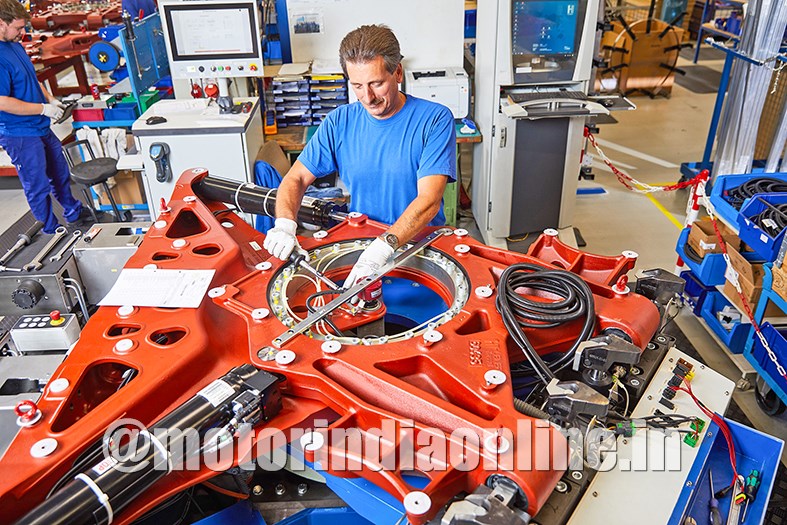Smart steering systems should pave the way for super buses that may accommodate up to 300 commuters
With cities growing in size and increasing urbanisation a widespread trend, the demands on public transport systems are also growing. In megacities and their surrounding regions, more and more people have to be transported in ways that are at once efficient and affordable. “Only through a strengthening of public transport offerings and the development of innovative approaches in the transport sector will it be possible for us to make progress with overcrowded streets and the associated environmental impacts,” remarks HÜBNER General Manager Helge Förster, responsible for the company’s mobility business segment.
The HÜBNER Group, a system supplier for the mobility industry based in Kassel, Germany, is therefore currently working on technical solutions for new high-capacity vehicles – a type of extra-long, multi-element bus that can transport as many as 300 passengers. The advantages of this approach: lower costs and shorter realisation times. Says Förster: “In cities lacking the necessary infrastructure, it can easily take 10-15 years to implement a new tram or light-rail system. This is a long time and it’s time that cities don’t have in the face of impending transport gridlock. New bus systems, by contrast, can often be realised within three to five years.” For this reason they are particularly attractive to municipalities and to transport companies.
Although there has been a trend towards longer bus vehicles for some time, until now the largest buses have operated as bi-articulated vehicles. “In the last few years, we have been looking more closely at how longer, multi-element buses could function, particularly in connection with vehicle configuration and dynamics,” explains Förster. When a bus is over 30 meters, as is currently planned, then this will require special electronic steering systems. “We want to start putting the first prototypes on wheels together with a manufacturer in the coming year,” reports Uwe Bittroff, head of the gangway systems division for street-based vehicles at HÜBNER.
The company will begin developing prototypes of a safe high-capacity vehicle in cooperation with a manufacturer next year. The new steering system will first be brought on the market after extensive testing has confirmed that a sufficient safety level can be guaranteed. According to HÜBNER, this process should take approximately three years. The challenge here is this: In order to ensure the safety of passengers and other road users, it must remain possible to control the steering system even when it has had a malfunction of some sort. “When six different axles are being managed by the steering system and just one of these does not want to go in the right direction, this can very quickly result in a hazardous situation,” emphasises the HÜBNER division leader.
The company is working on the development of the innovative new steering system together with the Fraunhofer Institute IVI in Dresden. “Currently we have put together a test station there with which we not only can simulate driving with such vehicles but also check the function of steering and axles,” says Bittroff. HÜBNER’s goal is to develop an electronic steering system that as much as possible is constructed and works on a standardised basis. With this approach it should also be possible for smaller vehicle manufacturers to be able to afford to produce multi-element articulated buses – without high development costs and with an acceptable level of effort for adaptation. HÜBNER wants to support customers with consulting services and inform them, for example, about required control units and sensor systems.
“We have put together a type of kit with suitable components from which customers can make selections,” explains Bittroff. HÜBNER itself will only be supplying the actual steering system components and customising them for the particular vehicle requirements. The company sees large markets for high-capacity vehicles, for example, in South America where bus rapid transit systems (BRT) have a long tradition. But other regions with growing metropolitan centres could also improve their transport systems with the help of super buses. China, for example, will also be playing an important role in this area with its megacities planned on the drawing board.
“Here the necessary infrastructure for high-capacity vehicles has been considered right from the beginning,” explains Bittroff. HÜBNER is involved in all of the projects that are currently being realised there. Bittroff also points out another trend to be found in China. Even more than in the bus sector, the tram sector has recognised the potential of high-capacity vehicles. As the world’s largest railway vehicle manufacturer, the China Railway Rolling Stock Corporation (CRRC), for example, is producing a sort of mixed vehicle type. Optically they are reminiscent of trams, but they drive on streets like a bus. Instead of making use of overhead lines, optical sensors ensure proper lane guidance of the vehicles
